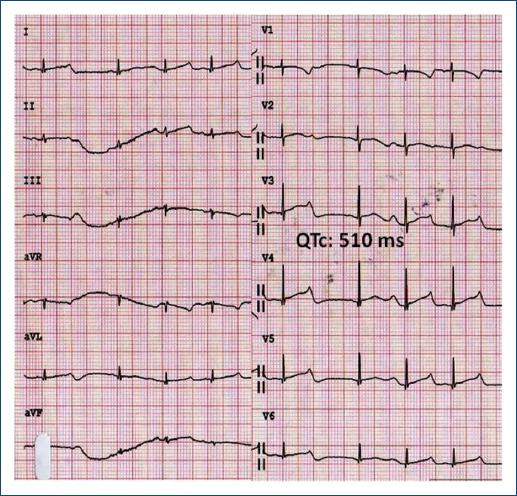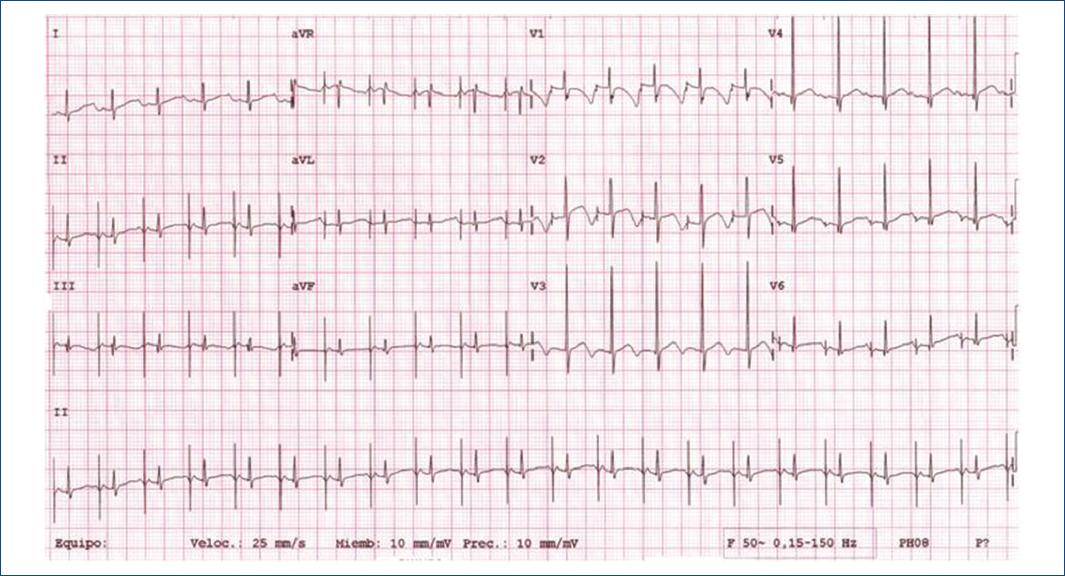The use of implantable cardioverter defibrillator (ICD) in pediatric age represents a challenge, because of anatomic limitations, increased risk of lead fracture, T wave oversensing and inappropriate therapies1. We present a case of a 4-year-old boy with no medical history of heart disease and no family history of sudden death, who was admitted to our institution with 1 month of recurrent syncope. He received treatment with lidocaine in other hospitals due to broad QRS complex tachycardia. The physical examination was unremarkable. The echocardiogram was normal. The electrocardiogram shows a long QTc of 510 ms and prolonged ST segment, suggesting long QT type III (LQT3) (Fig. 1).

Figure 1 Electrocardiogram with long QT type III with corrected QT (QTc) of 510 ms and prolonged ST segment.
During the 1st day of admission, he presented a polymorphic ventricular tachycardia with a heart rate of 220 bpm, preceded of premature ventricular contractions (Fig. 2).

Figure 2 Monitor trace with a polymorphic ventricular tachychardia started with premature ventricular contraction with R on T phenomenon (red arrow).
He required electric cardioversión with 1 J/kg and 2 J/kg in three occasions, afterward treatment with intravenous magnesium and beta-blocker was started. Then, a endocardial dual-chamber pacemaker was implanted in the 3rd day since admission without complications (Fig. 3). The patient was discharged 2 days after.

Figure 3 Electrocardiogram with pacemaker bicameral estimulation (DDDR mode), now with AAIR estimulation and shortening of the QT to 460 ms with a heart rate of 125 bpm.
In patients with LQT3 mutations, the ventricular arrhythmias occur more often during rest and bradycardia is an important triggering factor. The B-blockers may not be beneficial in this group, especially in symptomatic patients2. So that, pacemakers have shown to be an effective therapy in preventing sudden death3. In addition, dual-chamber pacing permits A-V synchrony, physiological heart rate, shortening of the QT interval and reduces the risk of R on T phenomenon4. Once the pacemaker has been implanted, the beta-blocker can started to prevent ventricular arrhythmias. In symptomatic small patients with pause dependent ventricular arrhythmias, the dual-chamber pacemakers are and adequate alternative until they grow up and ICD can be implanted3,4.











 nueva página del texto (beta)
nueva página del texto (beta)


